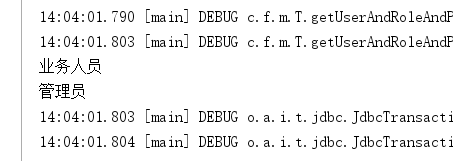现有t_user,t_user_role,t_role三张表,其中t_user_role是他们的中间表,t_user和t_role是多对多的关系
1 结果嵌套的方式
使用结果嵌套的方式来获得t_user表的tUser对象
TUser实体
创建一个List成员属性
TUserMappers接口
添加TUser getUserAndRoleAndPosition(Integer id);方法
TUserMappers.xml配置文件的设置
select语句
<select id="getUserAndRoleAndPosition" parameterType="java.lang.Integer" resultMap="getRoles" >
select *
from t_user tu,t_user_role tur,t_role tr
where
tu.id = tur.user_id
and
tur.role_id = tr.id
and tu.id = #{id,jdbcType=INTEGER}
</select>
resultMap的设置
<resultMap id="BaseResultMap" type="com.fxl.entities.TUser">
<id column="id" jdbcType="INTEGER" property="id" />
<result column="user_name" jdbcType="VARCHAR" property="userName" />
<result column="real_name" jdbcType="VARCHAR" property="realName" />
<result column="sex" jdbcType="TINYINT" property="sex" />
<result column="mobile" jdbcType="VARCHAR" property="mobile" />
<result column="email" jdbcType="VARCHAR" property="email" />
<result column="note" jdbcType="VARCHAR" property="note" />
<result column="position_id" jdbcType="INTEGER" property="positionId" />
</resultMap>
<resultMap id="getRoles" type="TUser" extends="BaseResultMap">
<collection property="roles" ofType="TRole" columnPrefix="role_">
<result column="id" property="id" />
<result column="Name" property="roleName" />
<result column="note" property="note" />
</collection>
</resultMap>
测试
@Test
public void getUserAndRoleAndPosition(){
SqlSession sqlSession = sqlSessionFactory.openSession();
TUserMapper mapper = sqlSession.getMapper(TUserMapper.class);
TUser user = mapper.getUserAndRoleAndPosition(1);
List<TRole> roles = user.getRoles();
for (TRole tRole : roles){
System.out.println(tRole.getRoleName());
}
sqlSession.close();
}
结果
2 查询语句嵌套的方式
使用查询语句嵌套的方式获得t_role表的tRole对象
TRole实体
创建一个List<TUser>的成员变量
TRoleMappers接口
添加 TRole selectByPrimaryKey(Integer id);方法
TRoleMappers.xml配置文件的设置
select语句
<select id="selectByPrimaryKey" parameterType="java.lang.Integer" resultMap="GetUser">
select id, role_name, note
from t_role
where id = #{id,jdbcType=INTEGER}
</select>
resultMap的设置
<resultMap id="BaseResultMap" type="com.fxl.entities.TRole">
<id column="id" jdbcType="INTEGER" property="id" />
<result column="role_name" jdbcType="VARCHAR" property="roleName" />
<result column="note" jdbcType="VARCHAR" property="note" />
</resultMap>
<resultMap id="GetUser" type="TRole" extends="BaseResultMap">
<collection property="users" column="id" select="com.fxl.mapper.TUserMapper.selectByRoleId">
</collection>
</resultMap>
TUserMappers接口
添加List<TUser> selectByRoleId(Integer roleId);方法
TUserMappers.xml配置文件的设置
select语句
<select id="selectByRoleId" resultMap="BaseResultMap" parameterType="java.lang.Integer">
select tu.id, tu.user_name, tu.real_name, tu.sex, tu.mobile, tu.email, tu.note, tu.position_id
from t_user tu,t_user_role tur
where tu.id = tur.user_id
and tur.role_id = #{roleId}
</select>
测试
@Test
public void getRoleAndUser(){
SqlSession sqlSession = sqlSessionFactory.openSession();
TRoleMapper mapper = sqlSession.getMapper(TRoleMapper.class);
TRole tRole = mapper.selectByPrimaryKey(1);
List<TUser> users = tRole.getUsers();
users.stream().forEach(e -> {
System.out.println(e.getUserName());
});
}
结果



